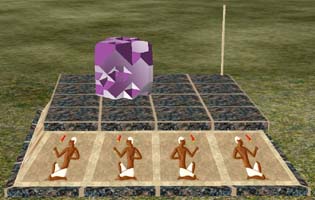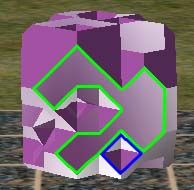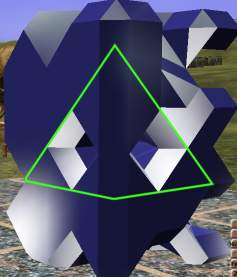Cuttable Gems
Cuttable gems come in four varieties (amethyst, garnet, lapis, and turquoise), and are acquired from water mines.
A water mine is built near water. Once wound, it will operate for about two hours. At Water Mine Data while the water mine is operating, a gem will appear on its tray. The appearance of a gem is accompanied by a distinctive "bloop" sound. Gems remain on the mine for about one minute before washing away.
If a water mine is built within 16 coordinates of another one, only one of the two mines will function at a time. (You will receive a notification if you are about to build one mine too close too another.)
The pitch of a water mine may be adjusted to a value from 10 to 30. The exact effects of pitch are poorly understood; it is certain, however, that the pitch affects the frequency with which each type of gem appears.
Water mines will occasionally produce normal, non-cuttable gems.
Cutting Gems
Cuttable gems may be cut into various shapes on a gemcutting table. Various types of cut gems are used in building many different structures.
Start by loading a cuttable gem onto a gemcutting table. Pin the table's menu for reference, but control the table using the keyboard. (Remember: to use keyboard hotkeys, press enter to disable chat and then place the mouse over the building to control.) Rotate the gem around to get a feel for the interface. It's easiest to control the table while using the explorer's camera (F6); stand on the far side of the table and look across it so the pole is located on the rear right. (See the image below.)
A cuttable gem is a 7x7x7 three-dimensional matrix of vertices. Each vertex may be present or absent. Facets form along the edges between present and absent vertices. Consider this gem:
The vertices on the outermost layer of the gem form a face, outlined in green. The outermost vertex at the point outlined in blue is missing, forming a divot in the gem. Holes like this are called "flaws" in the gem.
Each gem loaded into a cutting table will have a random set of flaws. Flaws always consist of a hole drilled straight into the gem from the outside in. You will never find a missing vertex deep within a gem that is not visible from the outside.
A gem may be cut using three sanding discs. Each disc will remove all the outermost vertices along a plane. Disc 1 removes the left side of the gem. Disc 2 removes the diagonal plane touching on the upper and front sides of the gem. Disc 3 removes the diagonal plane touching on the upper, front, and right sides of the gem. (All directions relative to the table image above.)
The goal is to sand a gem into one of a number of predetermined shapes. You may find an example of one of these shapes by using the gem catalog, available on the gem cutting table. The gem catalog will display a sample gem atop the pole on the table. Use these samples for reference while cutting.
Most types of cut gem can only be formed by taking advantage of flaws in the gem. For example, the "eyelet" cut requires a flaw two vertices deep, surrounded by unflawed vertices. The "full eye" cut is harder, requiring a three-vertex flaw. Before sanding any facets off a gem, examine it carefully to see what kinds of cuts can be made from it. Remember that there is no way to drill holes into a gem--the sanding discs will only remove planes.
Sculptors sometimes say that they see the statue hidden within a block of stone, and cut away all that is not a part of it. This is exactly how gems are made: The desired cut gem is hidden within the rough stone. Sand away all the vertices that are not a part of it.
When you have produced an exact match for a cut gem, complete the cut by selecting the type of gem you are making from the "finished cutting" menu of the cutting table. If your gem is an exact, vertex-for-vertex match for the sample in the catalog, it will be removed from the table. You may need to rotate the gem to the same alignment as the one in the catalog.
A gem cutting table may be upgraded with a "fine balance", which will indicate the weight of the gem being cut. The weight of a gem is equal to the number of set vertices remaining. Fine balances are of no real use to gemcutters.
Below are guides to cutting some specific types of gems.
Lens
The easiest cut to make. Use disc 1 to plane the gem down to a single flat layer with as few flaws as possible. Rotate the gem to lie parallel to the table, and use disc 3 to finish the job.
Amanti
An easy cut; any gem can be made into an Amanti.
First, use disc 1 to create a flat area on one face of the gem. Rotate this area onto the top of the gem. Use disc 2 to plane to the center of the flat area. Now rotate the gem 90 degrees about the Z axis, and again plane to the center with disc 2. Rotate and plane two more times. The point produced should be recognizable as one half of an Amanti. Flip the gem upside down, and repeat the process to produce the other half.
Queen's Tomb
An easy cut of moderate rarity.
A Queen's Tomb requires a single-vertex flaw, surrounded by two rings of unflawed gem. Look for a flat face with a single flaw in the middle of it. To cut the gem, rotate the flaw to face downwards, and use disc 3 repeatedly to form the sides of the pyramid.
King's Tomb
Easy to cut, but very rare. The King's Tomb is a larger version of the Queen's Tomb, and is made in exactly the same fashion.
Ring
If while attempting a Queen's Tomb, you happen upon a hole through the pyramid. Never fear, you have a ring in the works. All you need to do is flip the top of the ring up and use disc 1 on shave off two of the corners on the top of the ring. Refer to the gem catalog to see which corners.
Dragyn's Eye
A rare cut. To cut a dragyn's eye, you need two flaws the intersect in the same plane. It is ok if they just touch. It is even better if one or both continues past the intersection as it may give you more cutting options. From a top view, the two flaws will form an L, T, or + shape. Pick two legs that form an L to work on.
The next condition to look for is to find a right triangle that surrounds each flaw. The long side of the triangle will touch the edge of the diamond shape of the flaw, the other two sides touch the remaining corners. This image shows a gem that was later successfully cut into a Dragyn's Eye. The green highlighted lines show the unflawed section that you need to cut out.
If both flaws have non-flawed triangles around them that join on one edge, then it is quite likely the cut will work. The last spot to check is the location between the non-touching points of the triangles, as it also must not have a flaw. If it doesn't then the gem can be cut into a dragyn's eye.
Use disc 1 to flatten the sides so your triangles are revealed (it is likely the gem starts this way and no sanding is necessary).
Use disc 1 again to flatten the bottom so the triangles are sitting on the base.
Rotate the gem so that bottom is on the bottom and both triangles are facing away from disc 3. Use disc 3 until the Dragyn's Eye is revealed.
Unity
An easy cut of extremely annoyingly difficult rarity. It requires a flaw that is a hole 3 thicknesses deep and has a completely flawless area 2 thicknesses deep all around it. It is cut by shaping a cube around the hole (1 sander) and using the 2 sander to make the diagonal edges.
Useful Gems
A bold entry is useful for one or more buildings/skills, an entry in italics is only used for research at Universities. This may be used as a quick reference to see if a gem cut should be attempted for a gem type.
| Amethyst | Garnet | Lapis | Turquoise |
| Aidenn Mask | Aidenn Mask | Aidenn Mask | |
| Amanti | Amanti | Amanti | |
| Bastet | Bastet | Bastet | |
| Corner Heart | Choronzon | Choronzon | |
| Dalessi | Dalessi | Dalessi | |
| Dragyn's Eye | Dragyn's Eye | ||
| Eyelet | Eyelet | Eyelet | Eyelet |
| Full Eye | Full Eye | Full Eye | Full Eye |
| Hexas Plate | |||
| King's Tomb | King's Tomb | ||
| Lens | Lens | Lens | Lens |
| Looking Glass | Looking Glass | Looking Glass | |
| Queen's Tomb | Queen's Tomb | Queen's Tomb | Queen's Tomb |
| Thistle | Thistle | Thistle | |
| Unity | |||
| Symmetry | Symmetry |
The Aidenn Mask (amethyst, garnet, and lapis) and Unity (lapis) cuts are both extremely valuable. (Used in opticon construction and meglopolises, respectively.)
Here is the complete list sorted by gem-type of what buildings, skills, and university research require each cut Numbers in parantheses are the quantity required.
Amethyst
Buildings
Aidenn Mask - Opticon (1)Thistle - Opticon (1)
Lens - Opticon (1), Tower of Racing Mind (1), Charm Of Flight (1+)
Full Eye - Flax Gin Upgrade (2)
Eyelet - Empty Hand Tower Block (4), Venery lock (1)
Queen's Tomb - Set's Ladder (4)
Symmetry - Sawmill(2)
Looking Glass - Ritual Voting Booth (1)
Dragyn's Eye - Chime Tower (1)
Skills
Full Eye - Scrying (1)
Research
King's Tomb - Opticon Construction (5)Full Eye - Opticon Construction (20)
Corner Heart - Opticon Construction (5)
Aidenn Mask - Opticon Construction (20)
Amanti - Opticon Construction (30)
Dalessi - Opticon Construction (20)
Full Eye - Ring Mechanics (8)
Eyelet - Loom Automation (100, any type)
Garnet
Buildings
Bastet - Opticon (1)Aidenn Mask - Opticon (1)
Dalessi - Opticon (1)
Lens - Opticon (1), Point of Mind (0+)
Queen's Tomb - Opticon (1), Set's Ladder (4), Gemcutting Table's Fine Balance (2), Ritual Voting Booth (1)
Eyelet - Empty Hand Tower Block (4), Venery lock (1)
Symmetry - Sawmill(2)
Looking Glass - Ritual Voting Booth (1), Charm Of Flight (1+)
Amanti - Chime tower (1)
Skills
Full Eye - Scrying (1)
Research
Choronzon - Fine Balance (17)Thistle - Fine Balance (17)
Lens - Fine Balance (17)
Queen's Tomb - Fine Balance (17)
Eyelet - Loom Automation (100, any type)
Lapis
Buildings
Thistle - Arena (3), MegalopolisBastet - Arena (3)
Eyelet - Gearbox Design Bench (8)
Aidenn Mask - Opticon (1)
Lens - Opticon (1)
Queen's Tomb - Opticon (1), Set's Ladder (4), Ritual Voting Booth (1)
Eyelet - Empty Hand Tower Block (4), Venery lock (1)
Choronzon - Megalopolis
Dragyn's Eye - Megalopolis
Unity - Megalopolis
Hexas Plate - Megalopolis
Dragyn's Eye - Chime Tower (1)
Skills
Full Eye - Scrying (1)
Research
Eyelet - Loom Automation (100, any type)
Turquoise
Buildings
Amanti - Arena (3)Queen's Tomb - Arena (3), Opticon (1), Set's Ladder (4)
Dalessi - Opticon (1)
Lens - Opticon (1)
Eyelet - Empty Hand Tower Block (4), Venery lock (1)
Looking Glass - Ritual Voting Booth (1)
Amanti - Chime tower (1)
Skills
Full Eye - Scrying (1)
Research
Bastet - Conflict Shrine (20)King's Tomb - Conflict Shrine (5)
Queen's Tomb - Conflict Shrine (20)
Eyelet - Loom Automation (100, any type)
Specimen Cases
A specimen case may be used to remove a gem from the cutting table, even if it does not match any gem in the catalog. The gem may then be loaded back onto a table for future viewing. It is possible to remove a gem, place it back on the table, and then continue cutting it. Each specimen case can hold up to three gems (This is incorrect, each specimen case can hold only one gem).
Specimen cases cannot be made by any normal means. A small number have been given out as prizes in various events.
See also: School of Gem Cutting


